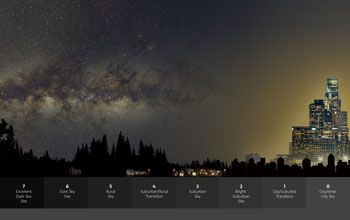Multimedia Gallery
Infographic illustrating effects of light pollution on star visibility
This infographic illustrates the effects skyglow, caused by light pollution, has on star-count. An analysis from Globe at Night, a citizen-science program run by the U.S. National Science Foundation’s NOIRLab, found that to the human eye, artificial lighting has dulled the night sky more rapidly than has been indicated by satellite measurements.
[NOIRLab is supported by the U.S. National Science Foundation.]
Learn more in the NOIRLab news story Infographic illustrating the impact of light pollution on our ability to see stars and other objects in the night sky. (Date of image: 2023; date originally posted to NSF Multimedia Gallery: Feb. 10, 2023)
Credit: NOIRLab/NSF/AURA, P. Marenfeld (Available under Creative Commons Attribution 4.0 International)
Special Restrictions: This photo is licensed under Creative Commons license Attribution 4.0 International.
Images and other media in the National Science Foundation Multimedia Gallery are available for use in print and electronic material by NSF employees, members of the media, university staff, teachers and the general public. All media in the gallery are intended for personal, educational and nonprofit/non-commercial use only.
Images credited to the National Science Foundation, a federal agency, are in the public domain. The images were created by employees of the United States Government as part of their official duties or prepared by contractors as "works for hire" for NSF. You may freely use NSF-credited images and, at your discretion, credit NSF with a "Courtesy: National Science Foundation" notation.
Additional information about general usage can be found in Conditions.
Also Available:
Download the high-resolution JPG version of the image. (837.0 KB)
Use your mouse to right-click (Mac users may need to Ctrl-click) the link above and choose the option that will save the file or target to your computer.

